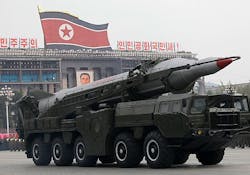Military researchers approach industry for rapid responses to time-sensitive enemy threats
Officials of the Washington Headquarters Services in Washington issued a broad agency announcement on Monday (HQ0034-19-BAA-TSTMPD-0001) for the Time-Sensitive Target Mission Payloads Demonstration project.
Experts are looking for offers on how to advance space-based and high-altitude-based payloads and enabling technologies that support attack operations against time-sensitive targets, including analysis, experimentation, and demonstration.
Enemy threats from missiles and other weapons of mass destruction continue to grow, which underlines the importance of maintaining defensive capabilities. This threat is likely to increase and grow more complex, officials say.
Enemy missiles are mobile, survivable, reliable, accurate, and long range. While deterrence is the preferred strategy against missile attack, a broader approach is necessary.
U.S. military capabilities to attack time-sensitive targets like mobile missiles prior to launch at stand-off-ranges with precision-strike weapons can disrupt, or destroy an enemy’s missiles before launch, and reduce the number of enemy missiles to be intercepted in flight.
Space-based and high-altitude reconnaissance assets like electro-optical and infrared satellites and synthetic aperture radar are crucial to engage time-sensitive targets. The same is true for targeting analysis, threat capability assessment, situational awareness, battle damage assessment, and fire control quality data.
Yet space is a naturally hazardous environment and is increasingly congested, contested, and competitive. Natural threats to satellites include solar activity, radiation belts, and natural orbital debris, while man-made threats include satellite debris, electromagnetic interference, jamming, lasing, cyber attacks, and anti-satellite weapons.
Features of a space-based or high-altitude sensor payload may include collecting intelligence under all feasible natural or hostile conditions; extracting target information in the presence of clutter and noise; processing information in real time; operating in harsh environments; exploiting artificial intelligence; using autonomy to reduce or eliminate human intervention; and demonstrating resiliency to enemy threats.
This project has three phases: white papers, concept design studies, and demonstrations. Companies should email white papers no later than 15 March 2019 -- nine days away -- to [email protected].
White papers should define a payload or enabling technology for attack operations against time-sensitive targets. Companies submitting promising white papers may be invited to participate in concept design studies and demonstrations.
Email questions or concerns to Sharon Hilton at [email protected] or Christina Gess at [email protected]. More information is online at https://www.fbo.gov/spg/ODA/WHS/REF/HQ0034-19-BAA-TSTMPD-0001/listing.html.
Ready to make a purchase? Search the Military & Aerospace Electronics Buyer's Guide for companies, new products, press releases, and videos
